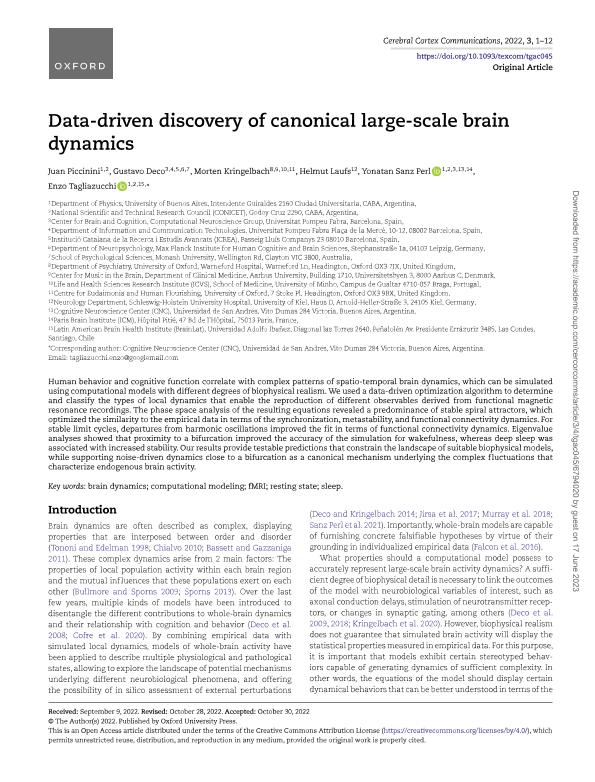Mostrar el registro sencillo del ítem
dc.contributor.author
Piccinini, Juan Ignacio

dc.contributor.author
Deco, Gustavo
dc.contributor.author
Kringelbach, Morten
dc.contributor.author
Laufs, Helmut
dc.contributor.author
Sanz Perl Hernandez, Yonatan

dc.contributor.author
Tagliazucchi, Enzo Rodolfo

dc.date.available
2023-08-01T17:39:42Z
dc.date.issued
2022-10
dc.identifier.citation
Piccinini, Juan Ignacio; Deco, Gustavo; Kringelbach, Morten; Laufs, Helmut; Sanz Perl Hernandez, Yonatan; et al.; Data-driven discovery of canonical large-scale brain dynamics; Oxford University Press; Cerebral Cortex Communications; 3; 4; 10-2022; 1-12
dc.identifier.issn
2632-7376
dc.identifier.uri
http://hdl.handle.net/11336/206393
dc.description.abstract
Human behavior and cognitive function correlate with complex patterns of spatio-temporal brain dynamics, which can be simulated using computational models with different degrees of biophysical realism. We used a data-driven optimization algorithm to determine and classify the types of local dynamics that enable the reproduction of different observables derived from functional magnetic resonance recordings. The phase space analysis of the resulting equations revealed a predominance of stable spiral attractors, which optimized the similarity to the empirical data in terms of the synchronization, metastability, and functional connectivity dynamics. For stable limit cycles, departures from harmonic oscillations improved the fit in terms of functional connectivity dynamics. Eigenvalue analyses showed that proximity to a bifurcation improved the accuracy of the simulation for wakefulness, whereas deep sleep was associated with increased stability. Our results provide testable predictions that constrain the landscape of suitable biophysical models, while supporting noise-driven dynamics close to a bifurcation as a canonical mechanism underlying the complex fluctuations that characterize endogenous brain activity.
dc.format
application/pdf
dc.language.iso
eng
dc.publisher
Oxford University Press

dc.rights
info:eu-repo/semantics/openAccess
dc.rights.uri
https://creativecommons.org/licenses/by-nc-sa/2.5/ar/
dc.subject
BRAIN DYNAMICS
dc.subject
WHOLE-BRAIN MODELS
dc.subject
DATA-DRIVEN MODELS
dc.subject
SLEEP
dc.subject.classification
Otras Ciencias Naturales y Exactas

dc.subject.classification
Otras Ciencias Naturales y Exactas

dc.subject.classification
CIENCIAS NATURALES Y EXACTAS

dc.title
Data-driven discovery of canonical large-scale brain dynamics
dc.type
info:eu-repo/semantics/article
dc.type
info:ar-repo/semantics/artículo
dc.type
info:eu-repo/semantics/publishedVersion
dc.date.updated
2023-07-27T14:26:21Z
dc.journal.volume
3
dc.journal.number
4
dc.journal.pagination
1-12
dc.journal.pais
Reino Unido

dc.description.fil
Fil: Piccinini, Juan Ignacio. Universidad de Buenos Aires. Facultad de Ciencias Exactas y Naturales. Departamento de Física; Argentina. Consejo Nacional de Investigaciones Científicas y Técnicas; Argentina
dc.description.fil
Fil: Deco, Gustavo. Universitat Pompeu Fabra; España
dc.description.fil
Fil: Kringelbach, Morten. University of Oxford; Reino Unido
dc.description.fil
Fil: Laufs, Helmut. University of Kiel; Alemania
dc.description.fil
Fil: Sanz Perl Hernandez, Yonatan. Universidad de Buenos Aires. Facultad de Ciencias Exactas y Naturales. Departamento de Física; Argentina. Consejo Nacional de Investigaciones Científicas y Técnicas; Argentina
dc.description.fil
Fil: Tagliazucchi, Enzo Rodolfo. Universidad de Buenos Aires. Facultad de Ciencias Exactas y Naturales. Departamento de Física; Argentina. Consejo Nacional de Investigaciones Científicas y Técnicas; Argentina
dc.journal.title
Cerebral Cortex Communications
dc.relation.alternativeid
info:eu-repo/semantics/altIdentifier/url/https://academic.oup.com/cercorcomms/article/doi/10.1093/texcom/tgac045/6794020
dc.relation.alternativeid
info:eu-repo/semantics/altIdentifier/doi/http://dx.doi.org/10.1093/texcom/tgac045
Archivos asociados
